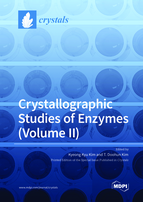Crystallographic Studies of Enzymes (Volume II)
A special issue of Crystals (ISSN 2073-4352). This special issue belongs to the section "Biomolecular Crystals".
Deadline for manuscript submissions: closed (31 March 2022) | Viewed by 22809
Special Issue Editors
Interests: enzymes; structures; esterase; deubiquitinase; noncanonical DNA
Special Issues, Collections and Topics in MDPI journals
Interests: protein-ligand interactions; enzyme structures; assay development; immobilization of enzymes
Special Issues, Collections and Topics in MDPI journals
Special Issue Information
Dear Colleagues,
Enzymes play a major role in the control of key biological processes, including metabolism and signaling, by accelerating chemical processes. Therefore, examining their structures and reaction mechanisms is essential for understanding not only the biological processes at a molecule level but also their application in various fields, such as protein engineering and drug development. Indeed, enzymes such as protein kinases or proteases can be considered major drug targets for many diseases. Although cryoEM and NMR provide useful structural information, X-ray crystallography is the best because it elucidates the atomic structure of enzymes, which can be used as a frame for structure-based protein engineering or drug development. In these aspects, enzyme crystallography can be considered a door leading to a new world.
In this Special Issue, we intend to collect research manuscripts on enzyme crystallography. However, since the goal of this issue is to provide rich resources on enzymes regarding their structural and functional aspects, we also encourage manuscript submissions of studies on the structure, function, and application of enzymes, which would provide complementary information for enzyme crystallography.
Prof. Dr. Kyeong Kyu Kim
Prof. Dr. T. Doohun Kim
Guest Editors
Manuscript Submission Information
Manuscripts should be submitted online at www.mdpi.com by registering and logging in to this website. Once you are registered, click here to go to the submission form. Manuscripts can be submitted until the deadline. All submissions that pass pre-check are peer-reviewed. Accepted papers will be published continuously in the journal (as soon as accepted) and will be listed together on the special issue website. Research articles, review articles as well as short communications are invited. For planned papers, a title and short abstract (about 100 words) can be sent to the Editorial Office for announcement on this website.
Submitted manuscripts should not have been published previously, nor be under consideration for publication elsewhere (except conference proceedings papers). All manuscripts are thoroughly refereed through a single-blind peer-review process. A guide for authors and other relevant information for submission of manuscripts is available on the Instructions for Authors page. Crystals is an international peer-reviewed open access monthly journal published by MDPI.
Please visit the Instructions for Authors page before submitting a manuscript. The Article Processing Charge (APC) for publication in this open access journal is 2600 CHF (Swiss Francs). Submitted papers should be well formatted and use good English. Authors may use MDPI's English editing service prior to publication or during author revisions.
Keywords
-
crystallization methods and developments
-
crystallographic determination of enzyme structures
-
enzyme engineering based on crystal structures
-
computational and modeling studies of enzymes
-
structure-based applications of enzymes
Related Special Issue
- Crystallographic Studies of Enzymes in Crystals (13 articles)







